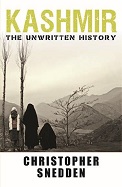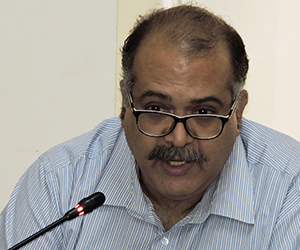Over the last few months, there is suddenly a lot of unnecessary, unwarranted and self-serving focus of Western academics, analysts and authors on the India-Pakistan equation – the issue of Jammu and Kashmir inevitably being a centre-piece of the discord between the two countries. Essentially the argument being made is that the problem in Afghanistan is more than anything else an outcome of the India-Pakistan proxy war and that the road to Kabul runs through Kashmir. In other words, Pakistan’s perfidious conduct in the War on Terror against Jihad International being fought in Afghanistan can be altered if some sort of a solution, which by definition is acceptable to Pakistan even if not to India, is worked out to satisfy Pakistan's irredentist claim over the Indian state of Jammu and Kashmir. With the US abandonment of Afghanistan in 2014 looming on the horizon, and the possibility of Afghanistan being outsourced to Pakistan becoming quite real, there seems to be a sense of urgency in attempts to create an intellectual environment in which the West (read US) can pressurise India to make concessions on Kashmir to Pakistan.
It is against this backdrop that former Australian intelligence officer and now academic Christopher Snedden’s book “Kashmir: The Unwritten History” has been published. While the timing of the book might seem mischievous, the fact of the matter remains that Snedden has been writing this book for some time now and just the kind of voluminous research that has gone into the book – practically every assertion is annotated – suggests that the author wasn’t necessarily working on any ‘agenda’. Even though Part II of the book does fill some gaps in our knowledge about the part of Pakistan occupied Kashmir which is euphemistically called ‘Azad Jammu and Kashmir’ (AJK, which is neither Azad nor Kashmir), the book plugs the Pakistani line on Kashmir even as it disguises itself as pushing the ‘Azad Kashmir’ cause. For instance, Snedden seems to subscribe to the pet conspiracy theory of Pakistanis that Gurdaspur was awarded to India in order to give the Indians access to Jammu and Kashmir. He ignores the documented fact that the Gurdaspur award had more to do with protection of Amritsar (which would otherwise be militarily vulnerable) than Kashmir.
Clearly, there are huge problems with the book, not the least of which is that almost all the sources that Snedden quotes are Pakistani, which in itself raises serious questions about the conclusions that are drawn in the book. Equally troublesome is the central thesis of the book which has to do with the Poonch ‘Uprising’ that Snedden projects as critical to developments that unfolded in the former princely state. And then there are the recommendations on how to solve the Kashmir issue that Snedden makes in the last part of the book, which are quite simply a convoluted pitch for plebiscite, albeit through the back door. Beguilingly presented as ‘Let the People Decide’, Snedden’s formula for solving Kashmir is nothing but a flight of fancy of an academic because it is unworkable, unacceptable and unreal.
The first impression that comes to mind after reading the book is that this is ‘Alistair Lamb 2.0’. Lamb was a British academic who in the 1990’s had published two books which not only questioned Kashmir’s accession to India but also portrayed India as the villain. Not surprisingly then, the Pakistanis used Lamb’s book to press their case on Kashmir, quoting from his works ad nauseam. But after it became known that the funding for Lamb’s book had come from Pakistani sources, Lamb suddenly stopped being quoted. This was a precursor to the sordid chapter involving the ISI funded shenanigans of Ghulam Nabi Fai of the Kashmir American Council. Surprisingly, however, Snedden’s book hasn’t received the same traction that Lamb had got in Pakistan. Perhaps, this is because of the pre-occupation of Pakistanis with their internal troubles.
The central thrust of Snedden’s book, and indeed his entire argument, is built around three developments that took place in the Jammu region in 1947 – the Poonch Uprising which was followed by communal violence in the Hindu majority eastern districts of Jammu region and finally the declaration of a provisional government by the rebels in Poonch. The salience that Snedden gives to the Poonch Uprising is unconvincing because it was at best a sideshow in the entire drama that unfolded in the state of Jammu and Kashmir in 1947. The importance that Snedden gives to the communal violence in Jammu – he even blames the tribal invasion by Pashtun tribesmen backed by the Pakistan army on the Jammu violence and presents it as the catalyst for the eventual Partition of the state of Jammu and Kashmir – flies in the face of historical facts. The communal violence in Jammu needs to be seen in the context of the great disturbances and dislocation that accompanied the monumental changes that were taking place in the Indian subcontinent at that time. That the Jammu violence could have been a reaction to the Poonch Uprising in which Hindus and Sikhs were massacred has been conveniently ignored.
Snedden’s assertion that the J&K dispute was started by the people of the state and not by Pakistan and that the Pashtun tribals invaded the state because of violence in Jammu is almost like saying that the invasion was some sort of instant coffee, which it clearly was not. There is no way that the Pashtun tribesmen could have launched their invasion within a couple of days of the violence in Jammu. There is enough evidence available that the planning for the tribal invasion had commenced months before the Jammu communal violence. Snedden himself accepts this when he points out that Pandit Nehru had informed Sardar Patel about the shenanigans of the NWFP and Punjab governments in the newly created Pakistan to stir trouble in J&K.
While Snedden portrays the Indian position on Kashmir, which blames the entire trouble on the tribal invasion, as being disingenuous, the fact of the matter is that all the troubles in the state that preceded the tribal invasion were localised and to an extent internal to J&K (notwithstanding the involvement of serving Pakistan Army officers and soldiers from the AJK region in stoking the fires and instigating the uprising in places like Poonch). The real problem arose because of open aggression by Pakistani proxies (to use a more contemporary phrase, non-state actors, which goes to show a certain pattern of behaviour on part of Pakistan in its dealings with India) to force the issue while maintaining plausible deniability. Snedden glosses over the rebellion by some state subjects and literally holds it up as a legitimate action. But surely, even he would agree that it is the legitimate right of every state to use every possible means (including accession to India in the case of the princely state of Jammu and Kashmir) to defend itself from both internal disturbance and external aggression. To accept Snedden’s specious argument would tantamount to justifying the terrorism that erupted in Jammu and Kashmir in 1989.
Perhaps the biggest problem with Snedden’s book is that because of his advocacy of the position of the people of AJK, he glosses over the ugly reality of the Kashmir problem and doesn’t acknowledge that the entire issue started as an unvarnished communal problem (Muslim majoritarianism) which in the 1990s took on hues of communalism varnished by ethnic nationalism and later became part of the international jihadist narrative. By ignoring this critical facet, Snedden has ended up writing an utterly biased and incomplete history of the Kashmir issue.











Post new comment